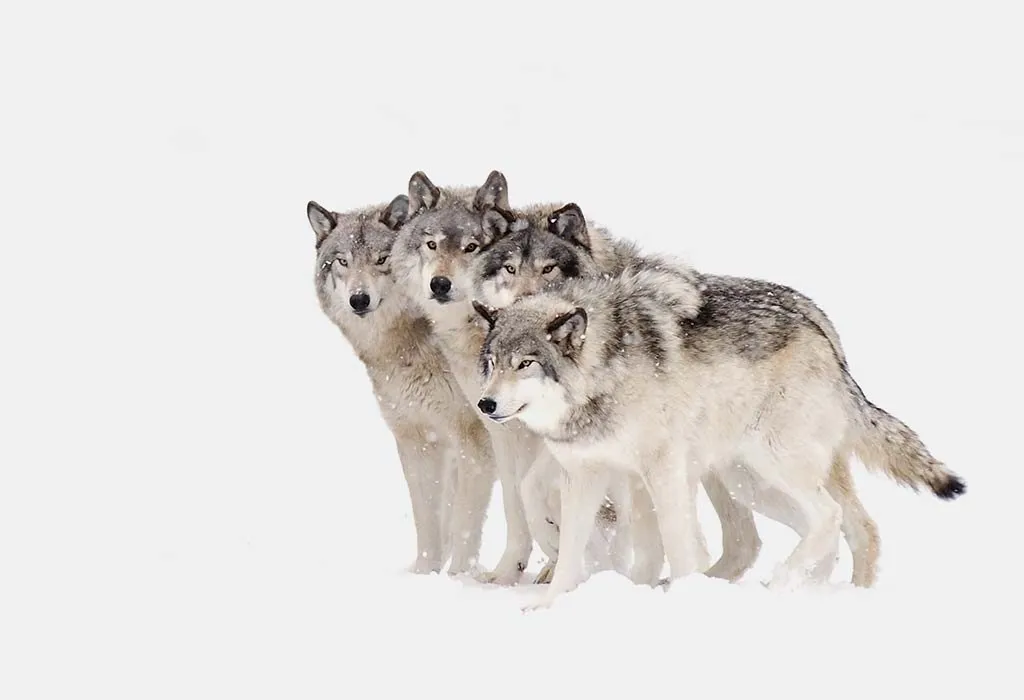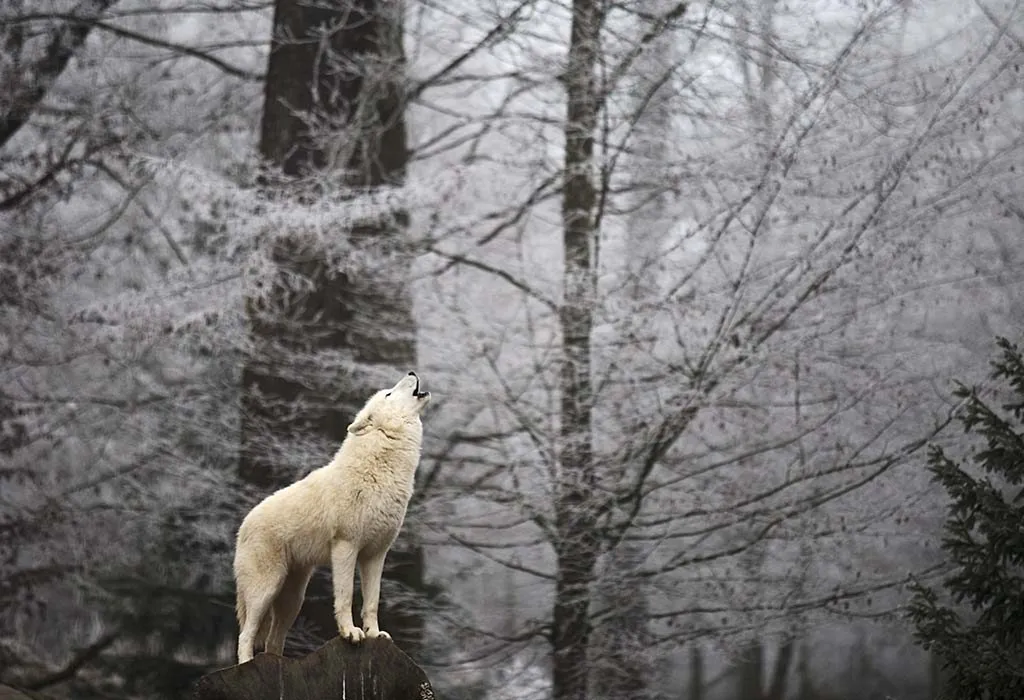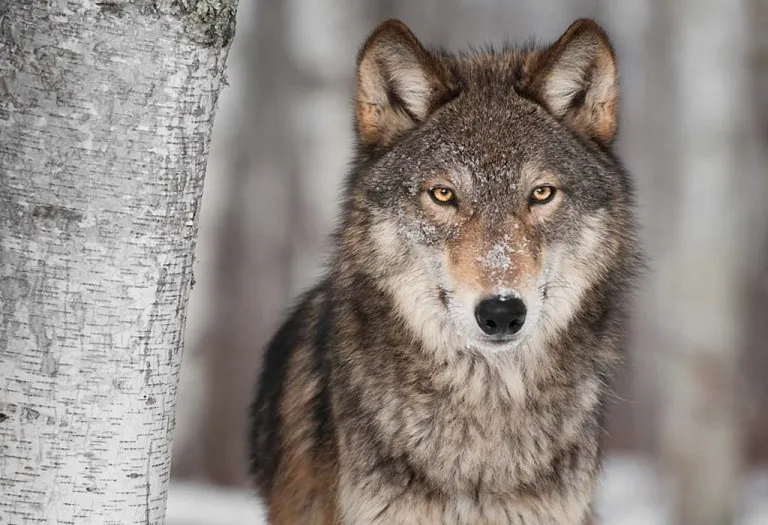24 Facts About Wolves for Kids
Kids learn about wolves by watching animated Hollywood movies and some TV commercials. The characteristic howling of this animal on a full moon night makes it so charming to watch. The fun fact is that they are mammals, meaning these wild animals have fur and feed their offspring milk. Step into the enchanting world of wolves, where untamed adventure awaits! These majestic creatures, known for their eerie howls and keen hunting skills, are more than just legends. Discover fascinating facts about their pack dynamics, clever communication, and incredible adaptations that make them the actual monarchs of the wilderness. There are various kinds of wolves out there, and if your child is wolf-curious, read this article to learn more about wolf facts for kids.
Interesting Facts About Wolves to Share with Kids
Whether it’s a snow wolf, red wolf, white wolf, or any other type, here are some exciting and fun facts about wolves for kids that are worth sharing:
1. They Weigh Up to 80 kg
One of the many wolves facts for kids is that they can weigh up to 80 kg! Generally, the average weight of wolves is 40 kg; the farther away they go from the equator, the heavier they get. In North America, the most prominent wolf killed was 75 kg. In addition, wolf packs are led by an alpha male from the herd, and usually, these packs consist of about six to ten wolves.
2. They Show No Mercy
Unlike in the movies, one of the interesting grey wolf facts for kids is that they show no mercy and don’t wait for their prey to move. They attack in groups coordinatedly and have specific signals and communication methods. Once they attack, unlike other animals, they tear their prey instantly and eat them alive. They never wait for their prey to die, and no special tricks are involved in killing them. It’s just a one-sided slaughter.
3. They Follow a Carnivorous Diet
Wolves are true carnivores to their core. They mostly eat large or medium hoofed animals but they also eat lizards, insectivores, reptiles, snakes, birds, rodents, and foxes. The alpha male and female of the group feed first and then the other members of the pack follow. They have razor sharp teeth which makes tearing down animals and clawing through the meat a lot easier. Also, wolves are known to care for their offspring and feed their pups what they hunt too. Some of them have been spotted eating fish too.
4. Where They Live
Wolves are very adaptive to different terrains and environments, but generally speaking, they are known to live in forests, deserts, grasslands, towns, and sometimes in the outskirts of cities.
5. They are Friendly Too
Wolves get aggressive only when they’re on their hunting spree – some species are very kind and gentle too. Siberian huskies (a relative of the wolf), for example, are domesticated by humans and kept as pets.

6. They are Fast
Wolves can run for many miles over the course of a day averaging at 5 mph. But when it comes to short distances, they can run up to speeds of 35 mph!
7. They Eat What They Get
There’s a reason wolves devour their prey immediately without mercy when they find them in sight. It’s because sometimes they have to go without food for days. Wolves aren’t picky eaters and usually eat whatever they get in front of them. Sometimes when they don’t get prey, they resort to eating livestock to compensate.
8. They Eat a Lot
The average wolf will eat up to 2.5 pounds of meat, but during the breeding season, this number will go up to 5 pounds a day.
9. About Their Lifespan
Most wolves live as long as 17 years. Grey wolves are known to have an average lifespan between six and eight years.
10. What They Look Like
Real life wolves don’t morph into werewolves or become humanised. The truth is, adult wolves stand up to 1.8 meters tall and the species that live in the north are usually bigger than the wolves in the south. At the shoulder height, they measure between 26 to 38 inches, and the colour of their fur varies between grey, white, red, black, or a combination of either of these.

11. They Can Protect Themselves
Since wolves always travel in a pack, they can protect themselves when an enemy tries hunting them. They have a keen sense of smell, sharp eyesight, and exceptional hearing ability. Since they run very fast, they can outmanoeuvre their enemies quickly, and they have tremendous amounts of stamina too.
12. Why They are an Endangered Species
Wolves are at the top of the food chain in the animal kingdom and the only species capable of hunting them down are humans. Loss of habitats through environmental pollution, industrial growth, and natural disasters are some of the reasons why they are becoming an endangered species these days.
13. They Breed Once a Year
Wolves are known to breed once a year and give birth to between 4 and 6 cubs during the breeding season. The average mortality rate for wolf pups stays at 50%, and wolves are known to be very kind to their young.
14. Guard and Undercoat
Guard and undercoat refer to the two kinds of hair wolves have. They shed hair in the spring and the summer in “sheets” unlike other animals.
15. They Can Smell From Miles Away
A wolf’s sense of smell is known to be 100 times stronger than that of humans.

16. The Largest of the Canidae Family
They’re the largest member hailing from the Canidae family. Their origin traces back to the coyote’s evolution which dates back 500,000 years.
17. Their Territories are Different
Wolf packs have different territories, each varying depending on the geographic location.
18. Feet and Ears
Wolves have very large feet, starting out at 4 inches wide and 5 inches long. Their ears are pointy and well-rounded, and they have 42 teeth.
19. They Can Track By Scent
Wolfs identify their territories through scent and attack any enemies or trespassers who are passing their grounds.
20. Territory Sizes Can Vary
In the U.S., the territory size of an average wolf pack is around 25 to 150 square miles, while in the Alaskan or Canadian wilderness, it goes up to between 300 to 1,000 square miles.
21. Whispering Wolves
In the forest’s depths, wolves communicate through subtle “whisper howls,” almost inaudible to humans. This secret language allows them to share information without alerting prey or rivals.
22. Aurora Borealis Connection
Some Arctic wolves are believed to synchronise their howling with the Northern Lights. Their eerie calls harmonise with the celestial dance, a phenomenon witnessed by very few.
23. Wondrous Wind-Eaters
Wolves can harness wind currents while hunting. They calculate precise angles and distances, allowing them to approach prey silently and undetected.
24. Wolf “Fingerprint” Howls
Each wolf has a unique howling style akin to a vocal fingerprint. This individualised call aids in identifying pack members and maintaining cohesion. It’s an acoustic signature only wolves understand.
FAQS
1. How Many Wolves Are There in the World?
The global wolf population varies, but it’s estimated to be around 200,000 to 250,000 wolves worldwide.
2. What Are Wolves Frightened Of?
Wolves are naturally wary of larger predators, including bears and humans. They may also exhibit fear or caution when faced with unfamiliar or threatening situations.
3. What Is a Female Wolf Known As?
A female wolf is known as a “she-wolf.” In the context of a wolf pack, she is often called the “alpha female.”
4. What Distance Can a Wolf’s Howl Be Heard?
A wolf’s howl can be heard over remarkable distances, up to 10 miles (16 kilometres) in open terrain. Their howling serves as a means of long-distance communication among pack members and can travel far due to the wilderness’ acoustic properties.
And that’s it. We hope you’ve enjoyed these interesting facts about wolfs for kids. Read this before bedtime and let your child get smarter and go wild with amazement!
Also Read:
Fascinating Dog Information for Kids
Amazing Facts About Giraffe for Children
Interesting Dinosaur Information for Kids
Starfish Facts and Information for Children
Was This Article Helpful?
Parenting is a huge responsibility, for you as a caregiver, but also for us as a parenting content platform. We understand that and take our responsibility of creating credible content seriously. FirstCry Parenting articles are written and published only after extensive research using factually sound references to deliver quality content that is accurate, validated by experts, and completely reliable. To understand how we go about creating content that is credible, read our editorial policy here.























